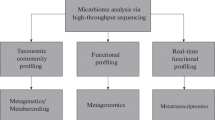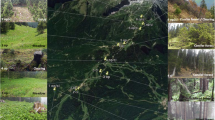Abstract
Traditional approaches to the study of microbial diversity have relied on laboratory cultivation of isolates from natural environments and identification by classical techniques, including analysis of morphology, physiological characteristics and biochemical properties. These approaches provide information on fine-scale diversity but suffer from bias, resulting from the media and cultivation conditions employed, and from the inability to grow and isolate significant proportions of natural communities in the laboratory. An alternative approach is the amplification of ribosomal RNA and functional genes from nucleic acids extracted directly from environmental samples, with subsequent analysis by `fingerprinting' methods or by sequencing and phylogenetic analysis. This approach avoids the need for laboratory cultivation and has provided major insights into species and functional diversity of bacterial and archaeal populations. This article reviews molecular approaches to the characterisation of prokaryote diversity in natural environments, their more recent application to fungal diversity and the advantages and limitations of molecular analyses.
Similar content being viewed by others
References
Amann R I, Krumholz L and Stahl D A 1990 Fluorescent-oligonucleotide probing of whole cells for determinative, phylogenetic, and environmental studies in microbiology. J. Bacteriol. 172, 762-770.
Atlas R M 1984 Diversity of microbial communities. Adv. Microbial Ecol. 7, 1-47.
Borneman J and Hartin R J 2000 PCR Primers that amplify fungal rRNA genes from environmental samples. Appl. Env. Microbiol. 66, 4356-4360.
Borneman J and Triplett E W 1997 Molecular microbial diversity in soils from Eastern Amazonia: Evidence for unusual microorganisms and microbial population shifts associated with deforestation. Appl. Env. Microbiol. 63, 2647-2653.
Borneman J, Skroch P W, O'Sullivan K M, Palus, J A, Rumjanek N G, Jansen J L, Nienhuis J and Triplett E W 1996 Molecular microbial diversity of an agricultural soil in Wisconsin. Env. Microbiol. 62, 1935-1943.
Bruns M A, Stephen J R, Kowalchuk G A, Prosser J I and Paul E 1999 Comparative diversity of ammonia oxidizer 16S rRNA gene sequences in native, tilled, and successional soils. Appi. Env. Microbiol. 65, 2994-3000.
Cavigelli M A, Robertson G P and Klug M J 1995 Fatty acid methyl ester (FAME) profiles as measures of soil microbial community structure. In Collins HP, Robertson G P and Klug M. J (Eds) The Significance and Regulation of Soil Biodiversity. pp 99-113 Kluwer Academic Publishers, Dordrecht, The Netherlands.
Felske A, Akkermans A D L and De Vos W M 1998 Quantification of 16S rRNAs in complex bacterial communities by multiple competitive reverse transcription PCR in temperature gradient gel electrophoresis fingerprints. Appl. Env. Microbiol. 64, 4581-4587.
Head, I M, Hiorns W D, Embley T M, McCarthy A J and Saunders J R 1993 The phylogeny of autotrophic ammonia-oxidizing bacteria as determined by analysis of 16S ribosomal RNA gene sequences. J. Gen. Microbiol. 139, 1147-1153.
Heid C A, Stevens J, Livak K J and Williams P M 1996 Real time quantitative PCR. Genome Res 6, 986-994
Jansson J K and Leser T D 1996 Quantitative PCR of environmental samples. Molecular Microbial Ecology Manual 2.7.4, 1-19.
Kowalchuk G A, Gerards S and Woldendorp J W 1997 Detection and characterization of fungal infections of Annophila arenaria (marram grass) roots by denaturing gradient gel electrophoresis of specifically amplified 18S rDNA. Appl. Env. Microbiol. 63, 3858-3865.
Kuske C R, Barns S M and Busch J D 1997 Diverse uncultivated bacterial groups from soils of the arid Southwestern United States that are present in many geographic regions. Appl. Env. Microbiol. 63, 3614-3621.
Lee N, Nielsen P H, Andreasen K H, Juretschko S, Nielsen J L, Schleifer K-H and Wagner M 1999 Combination of fluorescent in situ hybridization and microautoradiography-a new tool for structure-function analyses in microbial ecology. Appl. Env. Microbiol. 65, 1289-1297.
Liu W T, Marsh T L, Cheng H and Forney L J 1997 Characterization of microbial diversity by determining terminal restriction fragment length polymorphisms of genes encoding 16S rRNA. Appl. Env. Microbiol. 63, 4516-4522.
McCaig A E, Glover L A and Prosser J I 1999a Molecular analysis of eubacterial community structure and diversity in unimproved and improved upland grass pastures. Appl. Env. Microbiol. 65, 1721-1730.
McCaig A E, Phillips, C J, Stephen J R, Kowalchuk G A, Harvey S M, Herbert R A, Embley T M and Prosser J I 1999b Nitrogen cycling and community structure of ?-subgroup ammonia oxidising bacteria within polluted, marine fish-farm sediments. Appl. Env. Microbiol. 65, 213-220.
McCaig A E, Glover L A and Prosser J I 2001 Numerical analysis of grassland bacterial community structure under different land management regimes using 16S rDNA sequence data and DGGE banding patterns. Appl. Env. Microbiol. 67, 4554-4559.
Muyzer G, de Waal E C and Uitterlinden A G 1993 Profiling of complex microbial populations by denaturing gradient gel electrophoresis analysis of polymerase chain reaction-amplified genes coding for 16S rRNA. Appl. Env. Microbiol. 59, 695-700.
Ovreas L and V Torsvik 1998 Microbial diversity and community structure in two different agricultural soil communities. Microbial. Ecol. 36, 303-315.
Ouverney C C and Fuhrman J A 1999 Combined microautoradiography-16S rRNA probe technique for determination of radioisotope uptake by specific microbial cell types in situ. Appl. Env. Microbiol. 65, 1746-1752
Phillips C J, Smith Z, Embley T M and Prosser J I 1999 Phylogenetic differences between particle-associated and planktonic ?-proteobacteria ammonia oxidising bacteria in the North Western Mediterranean Sea. Appl. Env. Microbiol. 65, 779-786
Purdy K J, Nedwell D B, Embley T M and Takii S 1997 Use of 16S rRNA-targeted oligonucleotide probes to investigate the occurrence and selection of sulphate-reducing bacteria in response to nutrient addition to sediment slurry microcosms from a Japanese estuary. FEMS Microbiol. Ecol. 24, 221-234.
Purkhold U, Pommerening-Roser A, Juretschko S, Schmid M C, Koops H P and Wagner M 2000 Phylogeny of all recognized species of ammonia oxidizers based on comparative 16S rRNA and amoA sequence analysis. Implications for molecular diversity surveys. Appl. Env. Microbiol. 66, 5368-5382.
Radajewski S, Ineson P, Parekh N R and Murrell J C 2000 Stableisotope probing as a tool in microbial ecology. Nature 403, 646-649.
Smit E, Leeflang P, Glandorf B, Van Elsas J D and Wernars K 1999 Analysis of fungal diversity in the wheat rhizosphere by sequencing of cloned PCR-amplified genes encoding 18S rRNA and temperature gradient gel electrophoresis. Appl. Env. Microbiol. 65, 2614-2621.
Smith Z, McCaig A E, Stephen J R, Embley T M and Prosser J I 2001 Species diversity of uncultured and cultured populations of soil and marine ammonia oxidising bacteria. Microbial. Ecol. 42, 228-237.
Stephen J R, Kowalchuk G A, Bruns M A, McCaig A E, Phillips C J, Embley, TM and Prosser J I 1998 Analysis of ?-subgroup ammonia oxidiser populations in soil by DGGE analysis and hierarchical phylogenetic probing. Appl. Env. Microbiol. 64, 2958-2965.
Stephen J R, McCaig A E, Smith Z, Prosser J I and Embley T M 1996 Molecular diversity of soil and marine 16S rDNA sequences related to ?-subgroup ammonia oxidising bacteria. Appl. Env. Microbiol. 62, 4147-4154.
Torsvik V, Salte K, Sorheim R and Goksoyr J 1990 Comparison of phenotypic diversity and DNA heterogeneity in a population of soil bacteria. Appl. Env. Microbiol. 56, 776-781
Torsvik V, Sorheim R and Goksoyr J 1996 Total bacterial diversity in soil and sediment communities-a review. J. Ind. Microbiol. 17, 170-178.
Tunlid A, Hoitink H A J, Low C and White D C 1989 Characterization of bacteria that suppress Rhizoctonia damping-off in bark compost media by analysis of fatty acid biomarkers. Appl. Env. Microbiol. 55, 1368-1374.
Vainio E J and Hantula J 2000 Direct analysis of wood-inhabiting fungi using denaturing gradient gel electrophoresis of amplified ribosomal DNA. Mycol. Res. 104, 927-936.
Viaud M, Pasquier A and Brygoo Y 2000 Diversity of soil fungi studied by PCR-RFLP of ITS. Mycol. Res. 104, 1027-1032.
Author information
Authors and Affiliations
Rights and permissions
About this article
Cite this article
Prosser, J.I. Molecular and functional diversity in soil micro-organisms. Plant and Soil 244, 9–17 (2002). https://doi.org/10.1023/A:1020208100281
Issue Date:
DOI: https://doi.org/10.1023/A:1020208100281




